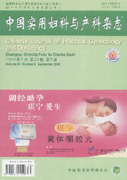Objective:Investigate the cause of intrauterine infection in late pregnancy, the main pathogens, its impact on maternal and child outcomes and prevention measures. Methods:International Peace Maternity & Child Health Hospital, Shanghai Jiao Tong University School of Medicine,253 cases was diagnosed of intrauterine infection in late pregnancy between January 1, 2006 and December 31,2011 were analyzed retrospectively. Results:The hospital in the past of six years the number of cases to intrauterine infection accounted for 0.41% of the same period the total number of deliveries, including preterm intrauterine infection accounted for 2.36% of the total number of premature delivery. Intrauterine infection is associated with premature rupture of membranes, to the time of treatment, the production process duration and the number of vaginal examinations and others. The main pathogens of intrauterine infection followed by GBS (20.6%), escherichia coli (19.4%), enterococcus faecalis (18.9%). Of the intrauterine infection patients, rate of cesarean section 76.7%, puerperal infection 14.2%, neonatal infection 20.9%, perinatal mortality 3.2%. Conclusions:To strengthen the health care during pregnancy and the management of treatment, the production process. Active prevention and timely diagnosis and treatment of intrauterine infection can improve the prognosis of female and children.

